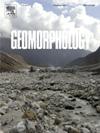Scratching beneath the surface: Using Ground-Penetrating Radar to disentangle pronival ramparts, embryonic rock glaciers and moraines (Gardetta Plateau, Southwestern Alps)
IF 3.1
2区 地球科学
Q2 GEOGRAPHY, PHYSICAL
引用次数: 0
Abstract
The distinction between debris ridges/ramparts that form at the base of mountain slopes in cold environments is important to understanding the (palaeo) environmental condition that prompted their formation. Despite the definition of diagnostic criteria, the identification of the formative (nival, permafrost creep, glacial) and post-depositional mechanisms remains uncertain as it is mostly reliant on surface observations. We present the results of a Ground-Penetrating Radar (GPR) survey carried out on landforms presenting similarities from a geomorphological perspective (i.e. pronival rampart, protalus rock glacier, moraine) in the same Alpine context. The 2D radar profiles provide imaging of the internal structure of these landforms, allowing us to formulate hypotheses on the depositional processes that led to their formation. In the pronival rampart, concave upward and mound-shaped radar reflections fit with the presence of a ridge/rampart at the base of a permanent snow patch. Mound-shaped, flat or counterslope reflectors reflect the existence of stratigraphic beds mantling the sides of the ridge and infill the depression between this and the talus upslope or the retreating snow patch front. Some sequences of GPR facies sequences are consistently referable to progradational/retrogradational depositional processes. Poor articulation of facies architecture characterizes frontal moraines and embryonic protalus rock glaciers. The succession of predominantly planar radar surfaces/facies is consistent with an important aggradational component that can be explained by a stratigraphic overlap of debris layers fed by the glacial front and/or of permafrost-affected sedimentary units.
The GPR imaging of the interior of these mountain landforms frequently found at the talus foot can offer crucial data for the correct interpretation of the formative mechanisms and, thereby of the environmental conditions that promoted their formation.

在地表下抓挠:使用探地雷达解开原始堡垒,胚胎岩石冰川和冰碛(加德塔高原,阿尔卑斯山西南部)
在寒冷环境下,在山坡底部形成的碎屑山脊/壁垒之间的区别对于理解促使它们形成的(古)环境条件非常重要。尽管定义了诊断标准,但由于主要依赖于地面观测,形成机制(冻土、永久冻土蠕变、冰川)和沉积后机制的确定仍然不确定。我们介绍了在相同的高山背景下,从地貌学角度(即前堡垒,原石岩冰川,冰碛)对地形进行的探地雷达(GPR)调查的结果。二维雷达剖面提供了这些地貌内部结构的成像,使我们能够对导致它们形成的沉积过程提出假设。在前缘堡垒中,凹向上和丘状的雷达反射与永久积雪区底部山脊/堡垒的存在相吻合。丘状、平坦或反坡反射体反映了覆盖在山脊两侧的地层层的存在,并填充了山脊与距坡上坡或后退的雪原前缘之间的凹陷。探地雷达相层序的某些层序与退积沉积过程一致。前缘冰碛和原生岩冰川的相结构不清晰是其特征。以平面为主的雷达表面/相的演替与一个重要的沉积成分相一致,这可以用冰川前缘和/或受永久冻土影响的沉积单元提供的碎屑层的地层重叠来解释。在距骨脚下经常发现的这些山地地貌内部的探地雷达成像可以为正确解释形成机制提供关键数据,从而为促进其形成的环境条件提供关键数据。
本文章由计算机程序翻译,如有差异,请以英文原文为准。
求助全文
约1分钟内获得全文
求助全文
来源期刊

Geomorphology
地学-地球科学综合
CiteScore
8.00
自引率
10.30%
发文量
309
审稿时长
3.4 months
期刊介绍:
Our journal''s scope includes geomorphic themes of: tectonics and regional structure; glacial processes and landforms; fluvial sequences, Quaternary environmental change and dating; fluvial processes and landforms; mass movement, slopes and periglacial processes; hillslopes and soil erosion; weathering, karst and soils; aeolian processes and landforms, coastal dunes and arid environments; coastal and marine processes, estuaries and lakes; modelling, theoretical and quantitative geomorphology; DEM, GIS and remote sensing methods and applications; hazards, applied and planetary geomorphology; and volcanics.
 求助内容:
求助内容: 应助结果提醒方式:
应助结果提醒方式:


